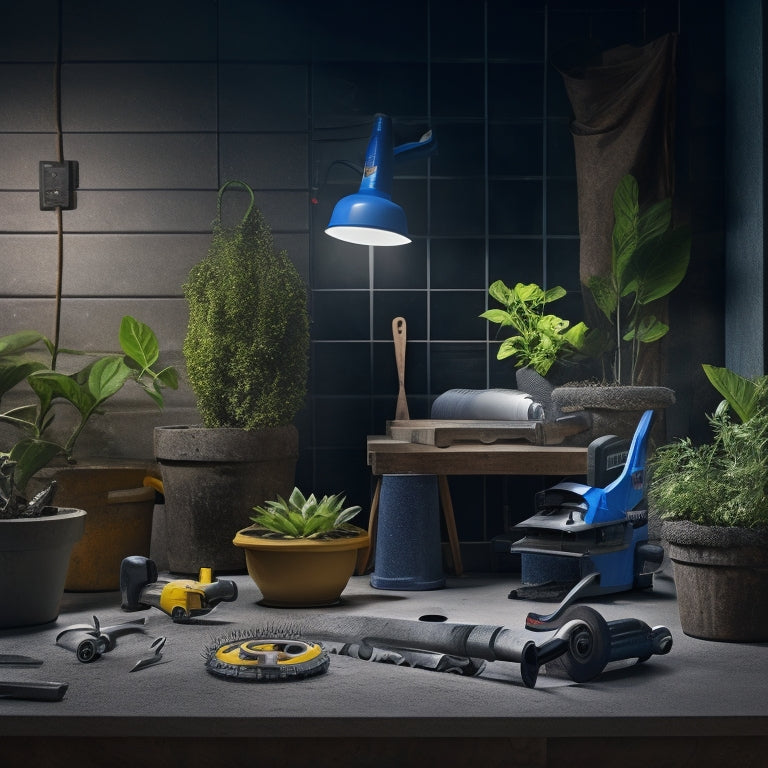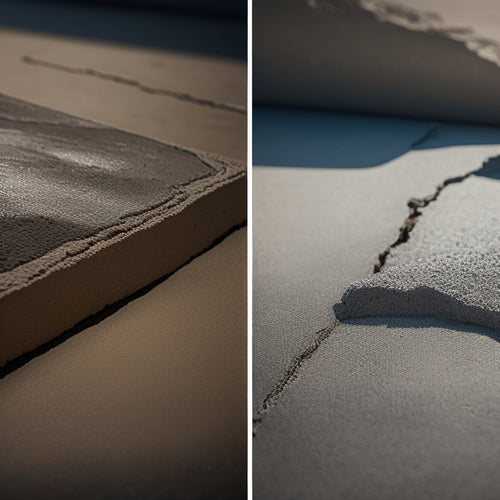
Top 3 Tools for Cutting Concrete Planters
Share
You'll need a trifecta of tools to cut through concrete planters: a circular saw with a diamond-coated or carbide-tipped blade for heavy-duty tasks, a diamond blade angle grinder for refining and shaping with precise cuts and curves, and a wet cutting tile saw for clean, straight cuts with its water-cooled system. Each tool requires specific considerations, such as blade selection, saw type, and safety measures, to guarantee efficient cutting and desired results. By mastering these tools, you'll realize the potential to craft intricate concrete planters, and with further exploration, uncover the nuances that set professionals apart.
Key Takeaways
• For heavy-duty concrete cutting, use a worm drive circular saw with a diamond-coated or carbide-tipped blade for efficient cutting.
• Diamond blade angle grinders are essential for refining and shaping concrete planters with precise cuts and curves, offering versatility and control.
• Wet cutting tile saws provide precision cutting with clean, straight cuts, and are ideal for larger planters, with larger blades and higher horsepower recommended.
• Proper blade selection and compatibility are crucial for efficient cutting, reducing wear and tear, and enhancing cutting efficiency.
• Safety measures, such as protective gear and well-maintained equipment, are vital when cutting concrete planters to prevent accidents and injuries.
Selecting the Right Circular Saw
When tackling concrete planter projects, you'll need a circular saw that can handle the dense, abrasive material. Choose one with a diamond-coated blade or a carbide-tipped blade specifically designed for cutting concrete. These blades are engineered to withstand the harsh conditions of concrete cutting, reducing wear and tear on your saw.
There are several circular saw types to take into account, each suited for specific tasks. Worm drive saws, for instance, provide more torque and are ideal for heavy-duty concrete cutting. Sidewinder saws, on the other hand, are more compact and versatile, making them perfect for smaller projects. Hypoid saws offer a balance between power and portability, making them a popular choice among professionals.
Proper blade selection is vital for efficient and safe concrete cutting. Diamond-coated blades are ideal for dry cutting, while carbide-tipped blades excel in wet cutting applications. Additionally, take into account the blade's thickness, arbor size, and rotation speed to ascertain it's compatible with your saw and suitable for your project's demands.
Diamond Blade Angle Grinders
With their versatility and maneuverability, diamond blade angle grinders prove to be an indispensable tool for refining and shaping concrete planters, allowing you to make precise cuts and curves in tight spaces.
Whether you're a seasoned pro or a DIY enthusiast, these grinders will become your go-to for tackling intricate designs and patterns.
Here are three key things to keep in mind when working with diamond blade angle grinders:
-
Choose the right diamond blade type: Select a blade that's specifically designed for concrete, as it'll provide the best results. You'll find blades with different diamond grits and bonding agents, so make sure to choose one that suits your project's requirements.
-
Prioritize grinder safety: Always wear protective gear, including gloves, safety glasses, and a dust mask. Confirm the grinder is properly secured and maintained, and never use it near water or in areas with poor ventilation.
-
Maintain control and precision: Hold the grinder at a 20- to 30-degree angle, applying gentle to moderate pressure. This will help you achieve smooth, accurate cuts and prevent kickbacks.
Wet Cutting Tile Saws
You'll find that wet cutting tile saws, designed for precise straight cuts, can be just as valuable as diamond blade angle grinders for shaping concrete planters, especially when working with larger, more rectangular designs. These saws are ideal for making clean, precise cuts in concrete, thanks to their water-cooled systems that reduce heat buildup and prevent damage to the blade or material.
Here are some key features to evaluate when choosing a wet cutting tile saw for your concrete planter project:
| Feature | Benefit | Recommended Spec |
|---|---|---|
| Blade Size | Larger blades for deeper cuts | 10' to 14' |
| Horsepower | More power for faster cutting | 1.5 to 2.5 HP |
| Water Flow | Consistent flow for efficient cooling | 1 to 2 GPM |
| Table Size | Larger tables for bigger planters | 24' x 24' to 36' x 36' |
| Fence System | Accurate alignment for precise cuts | Adjustable with measuring guides |
With a wet cutting tile saw, you'll achieve precision cutting and a professional finish for your concrete planters. By evaluating these key features, you'll find the right saw for your project and join the ranks of skilled crafters who demand exceptional results.
Frequently Asked Questions
Can I Use a Regular Saw Blade to Cut Concrete Planters?
You're wondering if a regular saw blade can cut concrete planters? Well, the short answer is no.
Standard saw blades aren't designed for concrete cutting and will likely wear out quickly or even break.
To cut concrete effectively, you'll need specialized saw blade types, like diamond-coated or carbide-tipped blades.
Additionally, it's important to employ specific concrete cutting techniques, such as slow, controlled movements and consistent water cooling to prevent overheating.
How Do I Minimize Dust When Cutting Concrete Planters?
When cutting concrete planters, you'll want to minimize dust for a cleaner, healthier work environment.
To do this, you'll need to focus on effective dust collection. One method is wet cutting, which involves using a saw or grinder with a constant water flow to suppress dust.
You can also use a vacuum with a HEPA filter or a dust-collecting attachment on your tool to contain the dust.
Are Concrete Planters Safe to Cut Indoors?
When you're thinking of cutting concrete planters indoors, a nagging concern creeps in - is it safe?
Let's clear the air: it's not exactly a walk in the park. You'll need to prioritize indoor safety by ensuring proper ventilation requirements are met.
Imagine a well-ventilated workspace where airborne particles are swept away, giving you peace of mind. If you can't guarantee that, it's best to take your project outside or consider alternative methods that don't involve cutting concrete indoors.
Your safety is worth it!
Can I Cut Concrete Planters With a Handheld Power Tool?
You're wondering if you can cut concrete planters with a handheld power tool. The answer is yes, but it requires precision and caution.
With handheld saws, like reciprocating saws or circular saws, you'll need to master specific cutting techniques. Visualize the cut path, secure the planter, and use a diamond blade or abrasive disc designed for concrete.
Work in a well-ventilated area, wearing protective gear, and maintain control to achieve a clean, accurate cut.
Do I Need to Seal the Cut Edges of Concrete Planters?
When you're working with cut concrete planters, you'll want to prioritize cut edge maintenance to prevent water seepage and damage.
You'll need to seal the cut edges to guarantee the planter's integrity. Use a concrete sealer or a waterproofing coating specifically designed for concrete, applying it according to the manufacturer's instructions.
This will help protect the planter from the elements and extend its lifespan. By sealing the cut edges, you'll create a durable, long-lasting planter that will thrive in its new environment.
Conclusion
As you stand back to admire your newly crafted concrete planter, the sweat on your brow and the dust on your shoes are evidence of the hard work you've put in.
And it's not just the physical labor - it's the precision and patience required to cut through that unforgiving concrete.
It's almost as if the clean lines and smooth edges of your finished piece are a reflection of your own perseverance.
Related Posts
-

What Tools Ensure Strong Concrete Adhesion at Home
You'll need the right tools to guarantee strong concrete adhesion at home. For surface preparation, use concrete surf...
-

Free Design Tools for Concrete House Planning
You can kick-start your concrete house planning project without breaking the bank, as there are several free design t...
-

10 Best Tools for Sealed Concrete Finishing Success
When it comes to sealed concrete finishing success, you need a robust arsenal of specialized tools. Start with essent...


